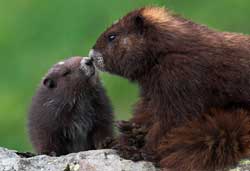
As well, last fall the Foundation welcomed Adam Taylor as the new Executive Director. Long-serving Viki Jackson took a well-deserved retirement. While Adam is new to marmots, he does arrive with a background in conservation and in protecting species at risk. For the past eight years he was the Executive Director of Habitat Acquisition Trust where he led projects to conserve many endangered species, including Western Painted Turtles, bats, snakes, and even endangered slugs!
“I am passionate about conserving our natural heritage” says Adam, “and the Vancouver Island Marmot is a special species that has a real chance to come back from the absolute brink of extinction thanks to the hard work of the Foundation and its partners. I am very excited to join the Foundation and to get to know these incredible animals better.”
Among the first marmots Adam met were young yearlings from the Calgary Zoo that arrived at the Tony Barrett Mount Washington Marmot Recovery Centre this spring.
Luke, Leia, Jabba, Anakin, and nine others travelled with the Foundation’s wildlife veterinarian, Malcolm McAddie from the Zoo to their temporary home on Mount Washington. “One yearling in particular was especially bold,” said Adam, “the very aptly named Han Solo wasn’t going to be put off his food just because I was hanging around watching.”
You’ve probably already noticed a theme in the names of these marmots. In honor of the new Star Wars film, all the yearlings were given Stars Wars names by the Calgary Zoo keepers. But while some of their namesakes are villains, all of these younglings are definitely heroes.
During their stay in the Centre on Mount Washington they will be implanted with transponders and then go through a quarantine period where their health is assessed and they are given a chance to adjust to the West Coast before being released. Later in the summer, they will join the nearly 300 wild marmots that now live in the mountains of Vancouver Island. It’s a great increase from just over a decade ago when only 30 remained in the wild, but there is no doubt that marmot’s recovery is still a work-in-progress.
Compared with other famous endangered species, there are still fewer marmots in the wild today than there are Giant Pandas (1500 to 3000), Mountain Gorillas (about 800), or Siberian Tigers (about 500). Fortunately for the marmots, unlike many other endangered species, their alpine habitat is still largely intact. “The meadows are still there, even if the marmots aren’t always” says Adam, “and where there is habitat, there is hope for the species.” Like the Jedi at the beginning of the original Stars Wars, the marmots are scattered and few, but there determined and dedicated people in their corner, and the marmots themselves are a tenacious and hard-working.
During a recent visit to Mount Washington, Adam witnessed first-hand how the marmots scamper up the steepest slopes and dig burrows in the rocky ground. “I was put to shame by the marmots, there was no way I could have kept up with them running up and down the rock piles and the hill. I’m glad I all I came to do was watch!”
He was also there for one of the sadder moments, as Joey and Jordan, members of the Foundation’s field crew, discovered that Revelstoke, a four year old marmot living on Mount Washington, had died. “It’s hard when you find a dead marmot. We know each of these marmots by name, and of course we do everything we can to ensure they have the best chance for survival.” But deaths do happen. In Revelstoke’s case, he died just after waking from hibernation, probably as result of low-energy reserves.
The period just after they wake from hibernation is an especially precarious time for Marmots. Their body fat reserves have been used up during their seven month sleep, but their digestive systems aren’t yet running at full-speed. Some just don’t have enough extra fat to get their bodies going and feeding properly again.
Spring is the changing of the seasons, and sometimes it is also a changing of the guard. Some of the young marmots from the Calgary Zoo will join the healthy colony at Mount Washington, and carry on the legacy of Revelstoke and other marmots that come before them. They truly are a “New Hope”, along with marmots like Nicola, Hollis, and Buffy who continue to enliven the slopes. In the background, Malcolm, Cheyney, field crew like Jordan and Joey, and now Adam will continue to support their recovery in the alpine of Vancouver Island.
For more information go to www.marmots.org
